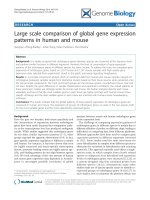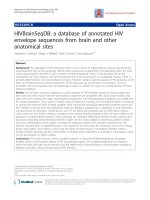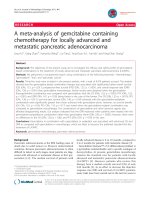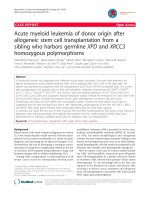Báo cáo y học: " Unusual towering elevation of troponin I after ST-elevation myocardial infarction and intensive monitoring with echocardiography post-percutaneous coronary intervention: a case report" ppsx
Bạn đang xem bản rút gọn của tài liệu. Xem và tải ngay bản đầy đủ của tài liệu tại đây (446.81 KB, 4 trang )
JOURNAL OF MEDICAL
CASE REPORTS
Javed et al. Journal of Medical Case Reports 2010, 4:137
/>Open Access
CASE REPORT
BioMed Central
© 2010 Javed et al; licensee BioMed Central Ltd. This is an Open Access article distributed under the terms of the Creative Commons
Attribution License ( which permits unrestricted use, distribution, and reproduction in
any medium, provided the original work is properly cited.
Case report
Unusual towering elevation of troponin I after
ST-elevation myocardial infarction and intensive
monitoring with echocardiography
post-percutaneous coronary intervention: a case
report
Fahad Javed*, Shahzeb A Khan, Emad F Aziz, Taimur Abbasi, Ramya Suryadevara and Eyal Herzog
Abstract
Introduction: The elevation of troponin levels directly corresponds to the extent of myocardial injury. Here we present
a case of a robust rise in cardiac biomarkers that correspond to extensive damage to the myocardium but did not spell
doom for our patient. It is important to note that, to the best of our knowledge, this is the highest level of troponin I
ever reported in the literature after a myocardial injury in an acute setting.
Case presentation: A 53-year-old African American man with an unknown medical history presented to the
emergency room of our hospital with chest pain associated with diaphoresis and altered mental status. He required
emergency intubation due to acute respiratory failure and circulatory collapse within 10 minutes of his arrival. He was
started on heparin and eptifibatide (Integrilin) drips but he was taken immediately for cardiac catheterization, which
showed a total occlusion of his proximal left anterior descending, diffuse left circumflex disease and severe left
ventricular dysfunction with segmental wall motion abnormality. He remained hypotensive throughout the procedure
and an intra-aortic balloon pump was inserted for circulatory support. His urinary toxicology examination result was
positive for cocaine metabolites. Serial echocardiograms showed an akinetic apex, a severely hypokinetic septum, and
severe systolic dysfunction of his left ventricle. Our patient stayed at the Coronary Care Unit for a total of 15 days before
he was finally discharged.
Conclusion: Studies demonstrate that an increase of 1 ng/ml in the cardiac troponin I level is associated with a
significant increase in the risk ratio for death. The elevation of troponin I to 515 ng/ml in our patient is an unusual
robust presentation which may reflect a composite of myocyte necrosis and reperfusion but without short-term
mortality. Nevertheless, prolonged close monitoring is required for better outcome. We also emphasize the need for
the troponin assays to be standardized and have universal cutoffs for comparisons across available data.
Introduction
ST elevation myocardial infarction with elevated cardiac
enzymes is a common scenario in emergency rooms.
Nowadays, it has become more evident in patients with
cocaine abuse. The elevation of troponins directly corre-
sponds to the extent of myocardial injury. We present a
case of a robust rise in cardiac biomarkers that corre-
spond to extensive damage to the myocardium but did
not spell doom for our patient. It is also important to note
how serial echocardiograms in this patient helped us
make important decisions regarding his management, all
the while keeping in mind his unique cardiac physiology.
Cardiac biomarkers serve as an important and essential
component of the initial evaluation of patients with acute
coronary syndrome (ACS). Cardiac biomarkers are intra-
cellular macromolecules that are released into the blood
* Correspondence:
1
Division of Cardiology, St. Luke's Roosevelt Hospital Center, University
Hospital for College of Physicians and Surgeons of Columbia University,
Amsterdam Avenue, 10025, New York, USA
Full list of author information is available at the end of the article
Javed et al. Journal of Medical Case Reports 2010, 4:137
/>Page 2 of 4
circulation due to myocardial injury and are available for
detection in the peripheral blood. With the advent of
point of care testing and improvement in sensitivity and
precision of newer assays, biomarkers not only play a role
in diagnosis but also add to prognostic data achieved
from history, physical and electrocardiogram (ECG) find-
ings. Like creatine kinase-MB (CK-MB), cardiac troponin
I concentrations begin to rise four to six hours after the
onset of symptoms and peaks in 18 to 24 hours.
Prospective studies of troponin (cTnI) assays in acute
coronary syndromes have demonstrated that cTnI have
diagnostic accuracy better than CK-MB [1-3], ECGs [3]
and can better predict long-term risk for adverse cardiac
events [4-6]. Troponins (I and T) have almost replaced
CK-MB as the predominant cardiac biomarker, thus rep-
resenting cardiac insult since the American College of
Cardiology and the European Society of Cardiology rede-
fined the criteria for acute myocardial infarction (MI).
However, interpretation of the aggregate data to date is
hampered by differences in cutoff values used to define
positive tests, the lack of assay standardization (cTnI), the
heterogeneity in patient populations to which the tests
have been applied, and variations in statistical analysis
and presentation of results for cardiac ischemia. In addi-
tion, while elevations in troponin I are being interpreted,
it is also essential to remember that troponin I can be ele-
vated in conditions other than ACS, such as sepsis, con-
gestive heart failure, renal failure, pulmonary embolism,
tachyarrhythmia and myocarditis.
Case presentation
A 53-year-old African-American man with a medical his-
tory of hypertension, smoking and rheumatic fever pre-
sented to the emergency room (ER) of our hospital with
chest pain. He reported his chest pain to be dull, subster-
nal, non-radiating, lasted over two hours and was associ-
ated with diaphoresis. Our patient was in severe
respiratory distress with worsening mental status. He was
immediately given aspirin, sublingual nitroglycerine and
statin, but required emergency intubation due to acute
respiratory failure and circulatory collapse on site within
10 minutes of his presentation.
His initial ECG in the ER showed ST elevations of >1.5
mm in leads V1 to V5, ST depressions in leads II and III
and VF and Troponin I level of 0.268 ng/ml with CK-MB
of 6.1 ng/ml and brain natriuretic peptide (BNP) of 444
pg/ml. He was also started on heparin and eptifibatide
(Integrilin) drips, but he was taken immediately for car-
diac catheterization, which showed total occlusion of his
proximal left anterior descending (LAD), diffuse left cir-
cumflex disease and severe left ventricular (LV) dysfunc-
tion with segmental wall motion abnormality. A drug
eluting stent (DES) was placed in his proximal LAD.
Meanwhile, a second set of cardiac enzymes showed
troponin I level of 515 ng/ml (Figure 1), CK-MB of 1120
ng/ml, and CK of 11623 ng/ml about six hours after his
presentation to the ER. Our patient remained hypoten-
sive throughout the procedure and an intra-aortic bal-
loon pump (IABP) was inserted. He was transferred to
Coronary Care Unit for further close monitoring and
management.
Subsequently, our patient's urinary toxicology examina-
tion result was positive for cocaine metabolites. A transt-
horacic echocardiogram showed severe LV dysfunction,
marked left ventricular hypertrophy, LV ejection fraction
of 15%, and akinesia of all his apical segments. His tro-
ponins gradually trended down to 42.1 ng/ml on the post-
MI day 4, which was a delayed trending course (Figure 1).
Our patient denied chronic cocaine abuse but also
mentioned that he was not complying with his home
medication of hydrochlorothiazide. At post-MI day six,
his IABP medication was discontinued upon careful
monitoring of his vitals. Serial echocardiograms con-
firmed persistent akinetic apex, a severely hypokinetic
septum, and severe LV systolic dysfunction. The poste-
rior wall thickness of our patient's heart was 19 mm and
an intravenous (IV) septum was found at 19 mm with an
apical aneurysm. His visually estimated LV ejection frac-
tion turned into 30% by day 12. Our patient stayed at the
Coronary Care Unit for a total of 15 days before he was
discharged.
Discussion
Studies have shown that each increase of 1 ng/ml in the
cardiac troponin I level is associated with a significant
increase in the risk ratio for death [4]. However, little is
known of the mortality risk in patients with troponin lev-
els of 100 ng/ml or above, and how much of aggressive
management these patients need after such a myocardial
insult. We do know that elevated levels of troponin I pro-
vide prognostic information beyond that supplied by the
Figure 1 Trend of our patient's Troponin I level over the first six
days of hospitalization.
Javed et al. Journal of Medical Case Reports 2010, 4:137
/>Page 3 of 4
demographic characteristics of patients or even the
results of electrocardiogram at their presentation [7].
The elevation of troponin I to 515 ng/ml within six
hours of PCI in our patient is an unusual presentation
which reflects a composite of myocyte necrosis and rep-
erfusion [8,9]. Many non-randomized [10] and random-
ized studies [11,12] have confirmed that early coronary
intervention attenuates the adverse prognostic impact of
troponin elevations [13]. Therefore, the peak of troponin
level in our patient can be attributed primarily to an
underlying coronary artery disease which was exacer-
bated by cocaine abuse, rather than secondary to the PCI
itself. This hypothesis, however, is still debatable.
The latest American College of Cardiology, American
Heart Association and Society for Cardiovascular
Angiography and Interventions PCI guideline integrates
available data and advocates measurement of biomarkers
eight to 12 hours after PCI. Our patient';s elevation of
troponin I post-PCI evidently points in favor of these rec-
ommendations. However, there is no standard troponin I
assay, thus we could not compare threshold values across
available studies [14,15]. In addition, we cannot deter-
mine which assay is most predictive of outcome. With the
availability of highly sensitive assays for the detection of
troponins, revised guidelines may be required for diag-
nostic and prognostic rise and fall in biomarkers in addi-
tion to symptoms or ECG changes significant for
ischemia and infarction.
Conclusion
The higher the peak of the troponins after ST segment
elevation myocardial infarction (STEMI), the larger the
infarct and the higher the risks of complications and
death [16,17]. However, the extent of the risk and what
should be considered the alarming elevation of troponin
is still unclear and needs further exploration. To directly
address the actual impact of this variable, future efforts
are needed in order to develop standard troponin cutoffs,
as well as further data collection across studies, to allow
for the combination of study results for pooled analysis or
meta-analytic techniques similar to that used by the
American College of Cardiology National Cardiovascular
Data Registry for cardiac catheterization procedures. If
accomplished, this might provide clinicians with a more
refined ability to immediately and accurately risk-stratify
patients with such high elevation of cardiac biomarkers.
Furthermore, it is pointed out that minor post-PCI tro-
ponin elevations do not appear to convey a significant
short- (or long-) term risk and do not warrant prolonga-
tion of hospitalization [18]. However, based on this case
report, we assert the need for additional monitoring of
patients with elevated cardiac biomarkers through car-
diac imaging-like bedside transthoracic echocardiograms
for an extended period of time in order to ensure better
monitoring, attenuate complications and augment better
outcomes.
Consent
Written informed consent was obtained from our patient
for publication of this case report and any accompanying
images. A copy of the written consent is available for
review by the Editor-in-Chief of this journal.
Competing interests
The authors declare that they have no competing interests.
Authors' contributions
FJ and RS were the primary care providers for our patient. EH and EA were the
supervising senior cardiologists for all interventions and imaging interpreta-
tions. FJ and SAK wrote the manuscript. EH and EA edited the manuscript. All
authors read and approved the final manuscript.
Acknowledgements
The authors are thankful to the entire nursing staff and team of the Coronary
Care Unit of Saint Luke's-Roosevelt Hospital Center, New York for their support
and efforts in the management of our patient.
Author Details
Division of Cardiology, St. Luke's Roosevelt Hospital Center, University Hospital
for College of Physicians and Surgeons of Columbia University, Amsterdam
Avenue, 10025, New York, USA
References
1. Polanczyk CA, Lee TH, Cook EF, Walls R, Wybenga D, Printy-Klein G, Ludwig
L, Guldbrandsen G, Johnson PA: Cardiac troponin I as a predictor of
major cardiac events in emergency department patients with acute
chest pain. J Am Coll Cardiol 1998, 32(1):8-14.
2. Ravkilde J: Creatine kinase isoenzyme MB mass, cardiac troponin T, and
myosin light chain isotype 1 as serological markers of myocardial
injury and their prognostic importance in acute coronary syndrome.
Dan Med Bull 1998, 45(1):34-50.
3. Muehlschlegel JD, Perry TE, Liu KY, Nascimben L, Fox AA, Collard CD, Avery
EG, Aranki SF, D'Ambra MN, Shernan SK, Body SC: Troponin is superior to
electrocardiogram and creatinine kinase MB for predicting clinically
significant myocardial injury after coronary artery bypass grafting. Eur
Heart J 2009, 30(13):1574-1583.
4. Antman EM, Tanasijevic MJ, Thompson B, Schactman M, McCabe CH,
Cannon CP, Fischer GA, Fung AY, Thompson C, Wybenga D, Braunwald E:
Cardiac-specific troponin I levels to predict the risk of mortality in
patients with acute coronary syndromes. N Engl J Med 1996,
335:1342-1349.
5. Olatidoye AG, Wu AH, Feng YJ, Waters D: Prognostic role of troponin T
versus troponin I in unstable angina pectoris for cardiac events with
meta-analysis comparing published studies. Am J Cardiol 1998,
81(12):1405-1410.
6. Green GB, Li DJ, Bessman ES, Cox JL, Kelen GD, Chan DW: The prognostic
significance if Troponin T and Troponin I. T. Acad Emerg Med 1998,
5:758-767.
7. Morrow DA, Rifai N, Tanasijevic MJ, Wybenga DR, de Lemos JA, Antman
EM: Clinical efficacy of three assays for cardiac troponin I for risk
stratification in acute coronary syndromes: a Thrombolysis in
Myocardial Infarction (TIMI) 11B Substudy. Clin Chem 2000,
46(4):453-460.
8. Miller WL, Garratt KN, Burritt MF, Lennon RJ, Reeder GS, Jaffe AS: Timing of
peak troponin T and creatine kinase-MB elevations after percutaneous
coronary intervention. Chest 2004, 125(1):275-280. Miller WL, Garratt KN,
Burritt MF, Lennon RJ, Reeder GS, Jaffe AS: Baseline troponin level: key
to understanding the importance of post-PCI troponin elevations.
Eur Heart J 2006 May, 27(9): 1061-1069
Received: 21 September 2009 Accepted: 18 May 2010
Published: 18 May 2010
This article is available from: 2010 Javed et al; licensee BioMed Central Ltd. This is an Open Access article distributed under the terms of the Creative Commons Attribution License ( which permits unrestricted use, distribution, and reproduction in any medium, provided the original work is properly cited.Journal of Medical Case Repo rts 2010, 4:137
Javed et al. Journal of Medical Case Reports 2010, 4:137
/>Page 4 of 4
9. Fuchs S, Kornowski R, Mehran R, Satler LF, Pichard AD, Kent KM, Hong MK,
Slack S, Stone GW, Leon MB: Cardiac troponin I levels and clinical
outcomes in patients with acute coronary syndromes: the potential
role of early percutaneous revascularization. Am Coll Cardiol 1999,
34:1704-1710.
10. Invasive compared with non-invasive treatment in unstable coronary-
artery disease: FRISC II prospective randomized multicentre study.
Fragmin and fast revascularization during instability in coronary artery
disease investigators. Lancet 1999, 354(9180):708-715.
11. Cannon CP, Weintraub WS, Demopoulos LA, Vicari R, Frey MJ, Lakkis N,
Neumann FJ, Robertson DH, DeLucca PT, DiBattiste PM, Gibson CM,
Braunwald E: TACTICS (Treat angina with aggrastat and determine cost
of therapy with an invasive or conservative strategy) thrombolysis in
myocardial infarction 18 investigators: comparison of early invasive
and conservative strategies in patients with unstable coronary
syndromes treated with the glycoprotein IIb/IIIa inhibitor tirofiban. N
Engl J Med 2001, 344:1879-1887.
12. Diderholm E, Andren B, Frostfeldt G, Genberg M, Jernberg T, Lagerqvist B,
Lindahl B, Venge P, Wallentin L: Fast revascularization during instability
in coronary artery disease (FRISC II) investigators: the prognostic and
therapeutic implications of increased troponin T levels and ST
depression in unstable coronary artery disease: the FRISC II invasive
troponin T electrocardiogram substudy. Am Heart J 2002, 143:760-767.
13. Panteghini M, Pagani F, Yeo KT, Apple FS, Christenson RH, Dati F, Mair J,
Ravkilde J, Wu AH: Committee on standardization of markers of cardiac
damage of the IFCC: evaluation of imprecision for cardiac troponin
assays at low-range concentrations. Clin Chem 2004, 50:327-332.
14. Apple FS: Clinical and analytical standardization issues confronting
cardiac troponin I. Clin Chem 1999, 45:18-20.
15. Ohman EM, Armstrong PW, Christenson RH, Granger CB, Katus HA, Hamm
CW, O'Hanesian MA, Wagner GS, Kleiman NS, Harrell FE Jr, Califf RM, Topol
EJ: Cardiac troponin T levels for risk stratification in acute myocardial
ischemia: GUSTO IIA investigators. Engl J Med 1996, 335:1333-1341.
16. Newby LK, Christenson RH, Ohman EM, Armstrong PW, Thompson TD,
Lee KL, Hamm CW, Katus HA, Cianciolo C, Granger CB, Topol EJ, Califf RM:
Value of serial troponin T measures for early and late risk stratification
in patients with acute coronary syndromes: the GUSTO-IIa
investigators. Circulation 1998, 98:1853-1859.
17. Prasad A, Rihal CS, Lennon RJ, Singh M, Jaffe AS, Holmes DR Jr:
Significance of periprocedural myonecrosis on outcomes after
percutaneous coronary intervention: an analysis of preintervention
and postintervention troponin T levels in 5487 patients. Circ Cardiovasc
Intervent 2008, 1:10-19.
doi: 10.1186/1752-1947-4-137
Cite this article as: Javed et al., Unusual towering elevation of troponin I
after ST-elevation myocardial infarction and intensive monitoring with
echocardiography post-percutaneous coronary intervention: a case report
Journal of Medical Case Reports 2010, 4:137









